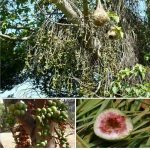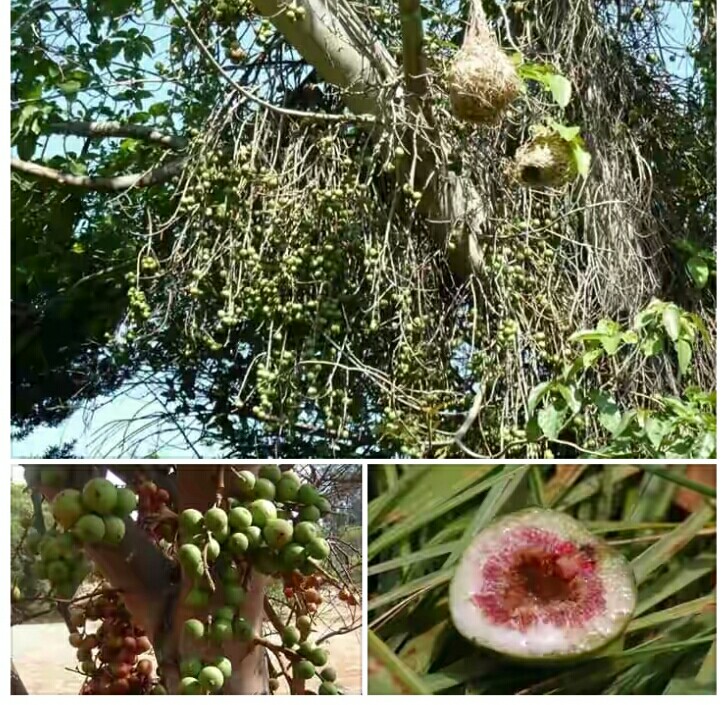Ficus sur; synonyms: Ficus capensis, Ficus mallotocarpa (Botanical name) or Broom cluster, Broom cluster fig, Bush fig, bush fig, Cape fig, Fig of heaven, Fire sticks, Kooman, Wild fig, Wild fig tree (English) or Uwar yara, Hugucuwa, Huguguwa, Dullu, Farin baure, Farin shaure, Garica (Hausa) or Akankoro (Igbo) or Opoto (Yoruba): A deciduous tree with edible fruits and medicinal values
DESCRIPTION AND OCCURRENCE: A large deciduous tree to 20 m and up to 150 cm in diameter, occasionally buttressed. BARK: smooth, grey, darker grey-brown with age. LEAVES: large, broadly oval, to 13 x 20 cm, usually smooth, edge often widely toothed, sometimes wavy, veins clear below, stalk grooved and flexible to 6 cm. FIGS: in heavy clusters on branches to 70 cm long from trunk or older wood, round, 2-4 cm across, on stalks, orange-red, often hairy, soft and edible but watery and tasteless, having many seeds and often insects too. Seeds are contained in figs with a fleshy part several centimetres thick.
MEDICINAL AND OTHER USES OF FICUS SUR
The ripe figs are sometimes eaten and are also made into jam. In Ghana they are fed to cage-birds. Young leaves are cooked and eaten as a vegetable. Young aerial roots are said to be edible as well.
The foliage is eaten by cattle, sheep and goats. The leaves are used as sandpaper.
The bark is chewed with kola in Sierra Leone. The inner bark is used to make rope and cloth. The bark yields a brown dye and is used for tanning leather. The latex is made into balls and bird lime.
The tree is used as an ornamental and shade tree, and in hedges; in Ethiopia it serves as a shade tree for coffee.
Ficus sur has many applications in traditional medicine, although the plant contains toxic substances and root and bark decoctions are recorded to have caused death.
Thus, care should be taken in using it. The latex is used for treating wounds, toothache, eye problems, general body pain, lung and throat problems, gonorrhoea and as an anti-emetic.
Root preparations are used for treatment of cough, sore throat, diarrhoea, stomach pain in babies, chest pain, infertility, uterine pain, gonorrhoea, oedema, and as an emmenagogue and emetic.
Bark decoctions or infusions are used against pain, rheumatism, diarrhoea, stomach problems, oedema in children, infertility and as a galactagogue (increase breastmilk production).
The powdered bark is applied on skin rashes and mouth sores. Bark macerations are drunk for treatment of fever and cough. Sap squeezed from leaves is applied onto wounds, and the leaves are chewed as a remedy for peptic ulcers. Leaf maceration is drunk against chest problems.
Leaf decoctions are used as a disinfectant wash and in the treatment of ophthalmia. Leaf infusions are drunk to treat tonsillitis and stomach pain. The sap of young shoots is taken against gonorrhoea.
Fig preparations are used to treat infertility, tuberculosis, abscesses and sores, and as a lactogenic, purgative and aphrodisiac.
The seed is used as a lactogenic. In veterinary medicine the leaves, figs and latex are said to stimulate milk production in cows, and the latex is given to cows to assist in expelling a retained part of the placenta after giving birth.
The latex and decoctions of the twig and leaf are recorded as being used for arrow poison and the plant has been used for criminal poisoning in Senegal.
Magical properties are often ascribed to the tree and it is a symbol of fertility. In Uganda the leaves are made into good-luck charms.
The wood is locally used for construction, furniture, mortars for grinding flour, kitchen utensils, pots, boxes, beer troughs, drums and beehives.
It is also suitable for sporting goods, agricultural implements, hardboard and particle board.
The wood was formerly used for making brake blocks and bed boards for ox wagons. Wood from the branches is made into knife-handles in the Central African Republic.
The wood is also used as fuelwood. In South Africa small pieces of wood are used as firesticks to ignite fire by friction.

FOR FURTHER READING SEE:
1. Burkill, H.M., 1997. The useful plants of West Tropical Africa. 2nd Edition. Volume 4, Families M–R. Royal Botanic Gardens, Kew, Richmond, United Kingdom. 969 pp.
2. Coates Palgrave, K., 1983. Trees of southern Africa. 2nd Edition. Struik Publishers, Cape Town, South Africa. 959 pp.
These are the thoughts and intellectual property of:
Sa’eed Halilu Bawa
Senior Lecturer (Associate Professor) at University of the West Indies, St. Augustine Campus, Trinidad.
Studied Food and Nutrition Sciences, Dietetics at Kaduna Polytechnic, Nigeria; Warsaw University of Life Sciences, Poland.
























